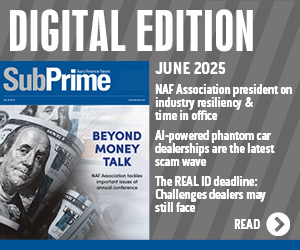Fitch keeps stable ABS outlook despite turbulence

With the firm also seeing captive finance companies likely to face continued pressure on profitability, Fitch Ratings noticed a wide array of headwinds impacting the auto ABS market, too.
However, Fitch is keeping its rating outlook as stable, according to its latest U.S. Auto ABS Index Report.
“Despite negative headlines in the auto sector, including weaker used values, Fitch Ratings continues to issue prime and subprime upgrades in 2017 given asset performance within or better than our forecasts,” Fitch’s Hylton Heard and John Bella Jr. said in the report shared with SubPrime Auto Finance News.
Looking deeper at the subprime sector, Fitch indicated annualized net losses reached 10.42 percent in February, almost hitting the segment high of 10.92 percent set in November.
“Tax refunds kicked in and losses declined through March but were 5.1 percent higher than in 2016,” Heard and Bella said.
“Fitch does not rate most of the smaller ABS platforms, but they are driving the (annualized net loss) index higher, particularly given the increase composition in the index versus three to four years ago,” said Heard and Bella, adding that securitizations from finance companies such as Santander Consumer USA and GM Financial previously had constituted the majority of their analysis. Now those two issuers make up only about 50 percent of their analysis pool as the other newcomers represent “well above historical levels.”
Heard and Bella continued by saying, “Despite a lot of positive economic factors, smaller lenders who rely heavily on ABS for funding could face financial issues were their portfolios continuing to underperform in 2017.”
Heard and Bella also noticed that some subprime finance companies are not originating as much paper as they previously had, prompting the Fitch experts to note in the report that “signs of pullback in lending a positive.”
They continued with, “It is a good sign that a number of large auto lenders/ABS issuers have tightened lending standards and retail volumes have declined, as sales declined moderately.”
Heard and Bella added, “The largest driver of weaker collateral underwriting is the high level of competition for lending over the past five years with interest rates low and lack of access to traditional bank lending for subprime borrowers.
“Lenders have begun tightening underwriting in response to weakening asset performance observed in 2016,” they went on to say in the report. “Fitch is observing some improvements in average credit quality of borrowers in ABS pools brought to market in 2017 and expects this trend will continue. However, longer term loans continued to represent an increased portion of originations, which may continue to pressure recoveries for early stage defaults.”
The Fitch experts still are keeping their ABS outlook as stable despite one other factor pointed out in the report — acknowledging that used-vehicle values are under pressure. They noted the Black Book Value Retention Index declined to 115.9 through March, a 6 percent year-over-year softening.
“Creeping default/repo volumes, along with very high lease returns, are affecting used values. New-vehicle days’ supply have crept higher and sales dipped, while incentives are at record levels, all negatives for wholesale values,” Heard and Bella said.
Captives under pressure, too
In a separate report, Fitch Ratings determined captive finance companies are likely to face continued pressure on profitability due to rising credit losses, declining residual values and higher funding costs. The firm made that assertion according to a review of U.S. captive finance companies from Fitch Ratings.
In addition, after a solid 2016, portfolio growth is likely to moderate over the near term, particularly for consumer-oriented companies, as U.S. auto sales are expected to decline. Average portfolio growth for the captives in this report was 4.5 percent in 2016, up slightly from 3.9 percent in 2015.
Analysts indicated average pretax earnings margins were 23 percent in 2016, down from 29 percent in the prior year, due primarily to weakening asset quality, declines in used vehicle prices, and competitive pressure on asset yields.
"Weaker credit performance is likely to continue in 2017, with both charge-offs and delinquencies climbing from historically low levels as a result of portfolio seasoning and lower recovery rates on defaulted auto loans," said Michael Taiano, director at Fitch Ratings.
The review also showed overall credit quality for consumer and commercial captives in 2016 continued to weaken, which was consistent with Fitch's expectations following post-crisis lows that were unsustainable. Average net loss rates for the captives included in this report increased “meaningfully” to 0.82 percent in 2016 from 0.61 percent in 2015. The increase in net credit losses was most pronounced within the auto captive segment.
Fitch also noted leverage has been on the rise for several captives.
Analysts found that the average leverage for the group ticked up slightly at the close of 2016 to 7.5 times versus 7.4 times in 2015, with many captives currently at or near five-year averages. Fitch explained that captive leverage, as measured by debt to tangible equity, is typically higher relative to many stand-alone finance companies in part due to explicit or implicit parent support.
The firm added that the willingness of parent companies to inject capital and/or reduce/forgo dividends to support asset growth has limited further increases in leverage. Fitch expects U.S. captive portfolio growth to moderate in 2017, which should limit further increases in leverage for most, absent material credit deterioration.
“The slight increase in leverage reflects stronger portfolio growth relative to more moderate earnings growth,” Taiano said.


